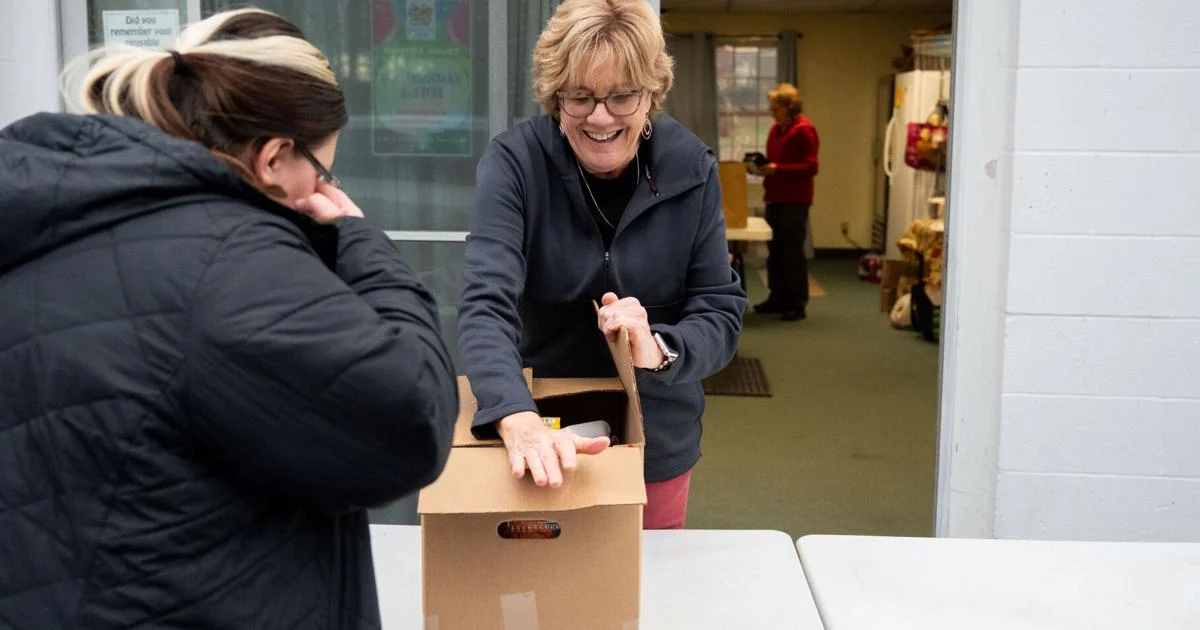Copyright keenesentinel

Food pantries and other welfare agencies in the Monadnock Region have been hastily pulling together plans this week to accommodate the expected inflow of SNAP recipients poised to not receive their benefits in November. As the federal government shutdown drags on, more than 75,000 SNAP recipients in the Granite State — roughly 5,000 in Cheshire County — are at risk. Leaders of local food pantries said they have already been seeing increased demand for food because of inflation, and in recent days, have fielded calls and comments from SNAP recipients anxious about having enough food. The region’s pantries are using a slew of strategies to cope with what could be a sudden and drastic increase in demand. Organizations are soliciting more donations, extending their hours, changing how they operate and making plans for an even higher need for food. Despite their best efforts, however, food pantries are a temporary fix, said Elsy Cipriani, executive director of the N.H. Food Bank. “No one across the state and across the United States has the capacity to replace SNAP,” she said. Food pantries and the state can offer temporary relief but neither can duplicate SNAP’s scale and reach, she added. The largest hunger-relief program in the nation, the federal Supplemental Nutrition Assistance Program, formerly known as food stamps, supports 41 million people, or 12 percent of the U.S. population, according to the think tank Center for Budget and Policy Priorities. Eligibility is based on federal income and asset guidelines. The USDA said SNAP benefits will not go out Saturday because of the government shutdown. And as this date draws near, SNAP recipients in the region have been scrambling to secure other sources of food. “Our phone is ringing off the hook,” said Jennifer Dassau, executive director of Feeding Tiny Tummies in Keene. “They’re emailing me, they’re texting me, they’re calling the office.” Tiny Tummies has a twice-a-week food pantry program, where about 200 families per day get food. But this past Tuesday, the pantry was much busier than normal and there were lines, according to Dassau. She expects this trend to continue. Dassau said her organization is working to secure more food donations, and is considering making changes such as offering to-go bags to help people get food faster. She said staff are committed to feeding as many people as possible in whatever way they can. “We’re just trying to be creative,” she said. “I don’t know what we’re going to do.” At The Community Kitchen in Keene, leaders are collaborating with the N.H. Food Bank and the city to put in place a separate distribution site for SNAP recipients. The site, slated for the Public Works Department at 350 Marlboro St., is part of a $2 million contingency plan from the N.H. Department of Health and Human Services to feed SNAP recipients for the next five weeks. The Community Kitchen’s first distribution at the public works site is scheduled for Saturday, Nov. 8, from 9 a.m. to 1 p.m., according to Executive Director Barb Weisman. She said recipients will have to show their Electronic Benefits Transfer, or EBT, cards to receive the food. Distribution is expected to last up to five weeks, she added. Cipriani, the executive director of the N.H. Food Bank, referred all questions about the plan, as well as about locations of other distributions sites, to the state health department, which she said would release additional information in the coming days. A department spokesperson said Thursday the agency was working with the N.H. Food Bank to finalize the list of distribution sites as well as select food pantries that will have additional boxes for SNAP recipients. In the rural parts of the region, where people are more spread out and pantries are smaller — many of them run entirely by volunteers — churches and other welfare organizations accustomed to serving dozens are now planning to meet much higher demand in their communities. The Hinsdale Food Shelf serves 25 to 30 families a month but is gearing up to serve double that number or more beginning next week, said Bethany Marx, the town’s program director. The pantry, which runs from the community center on Main Street and is open to town residents of all incomes, gets most of its supplies through donations. In recent days, as news of the impending loss of SNAP benefits spread, Marx said she and Assistant Program Director Kristie Dube began preparing. “We were hoping that there would be some type of relief from the federal issue, Marx said. “When we didn’t start to see this this week, we started game-planning.” To accommodate the increased need, the pantry, which normally opens on Mondays from 11 a.m. to 2 p.m., is extending its hours to 10 a.m. to 4 p.m., with separate times by appointments for residents who can’t make it to the community center during that window. The food shelf will allow residents to get food twice a month, up from the previous once-a-month limit. Marx said the pantry is suspending most of its giveaways of household and hygiene items and diverting these resources to purchasing more food. The food shelf is also soliciting additional donations and is talking to local churches about offering a community supper. But the pantry can accommodate this ramped-up demand for only so long. She said staff are planning to offer enhanced services until January, but the exact date and what food would be offered depends on what the community can muster. “We know that beginning next week, it will be a very scary time for people and very busy for us,” she said. In some cases, support from larger organizations in the region has bolstered supplies to rural pantries, a relationship that could help smaller organizations meet the growing need in their towns. The Community Kitchen in Keene shares resources with several rural pantries, including in Rindge, Troy, Marlborough and Chesterfield. Weisman, the executive director, said the goal is to strengthen the pantry ecosystem in the region. Dassau, of Feeding Tiny Tummies, has also been sharing food with smaller pantries in Stoddard, Marlow and Sullivan. Still, she worries about their capacity to handle a spike in demand. “I’m concerned,” she said. “I’m lying awake at night wondering what we’re going to do.” Marcia Levesque, food pantry coordinator of the Marlow Neighborhood Food Pantry, said it’s too early to know how the lack of SNAP benefits in November would affect the pantry. The pantry, which serves Marlow residents, is open on the third Sunday of the month and normally serves 10 to 15 families. It’s supported by donations and town money, according to Levesque, and also gets food from Feeding Tiny Tummies. To prepare for possible increased need, volunteers recently decided to offer additional food outside the normal pickup to any resident who is struggling to make ends meet, she said. Levesque said the link to Tiny Tummies, which has enabled the organization to offer larger boxes, will also help volunteers respond to a growing need for food. “I think we’re just waiting to see what kind of impact it has on us.”



